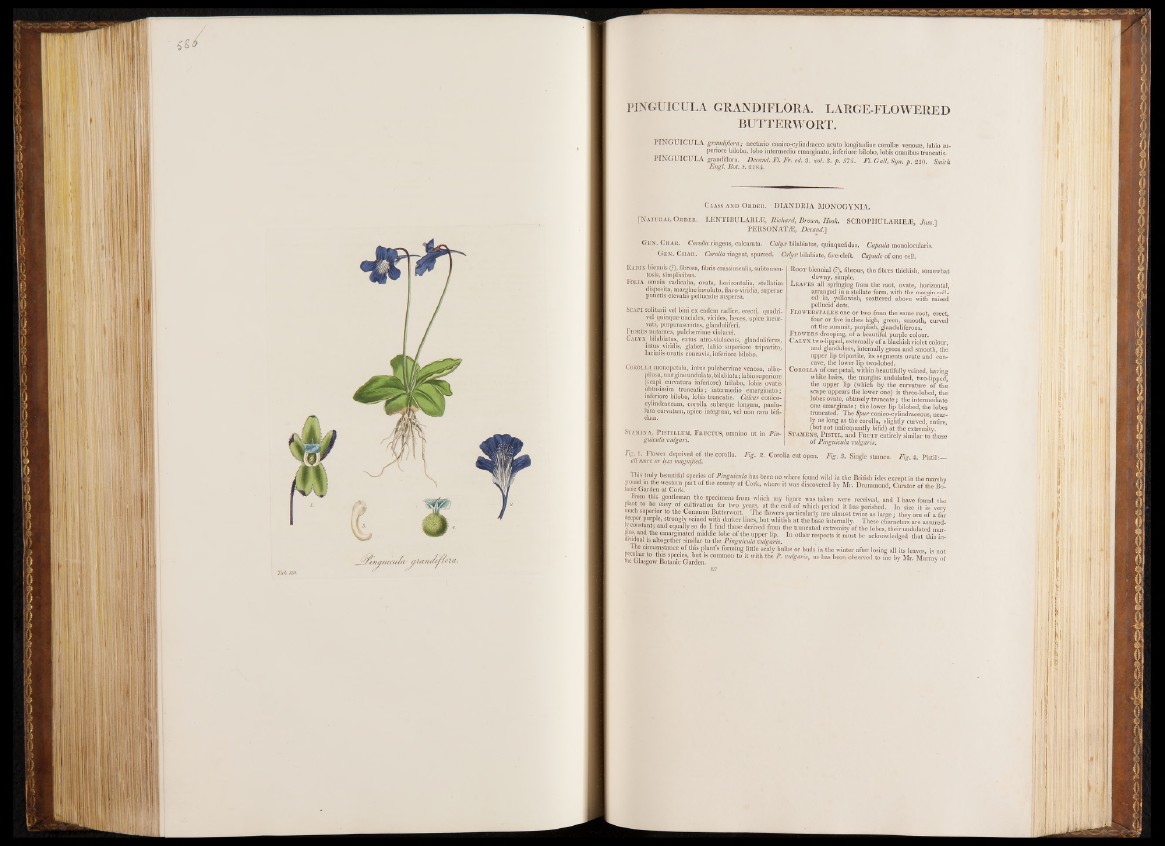
PINGUICULA GRANDIFLORA. LARGE-FLOWERED
BUTTERWORT.
PINGUICULA grandiflora; nectario conico-cylindraceo acuto longitudine corollæ venosæ, labiosu-
periore bilobo, lobo intermedio emarginato, inferiore bilobo, lobis omnibus truncatis.
PINGUICULA grandiflora. Decand. Fl. Fr. ed. 3. vol. 3. p . 575. Fl. Gall. Syn. p 230 Smith
Engl. Bot. t. 2184.
Class a nd Ord e r . DIANDRIA MONOGYNIA.
[N atural Ord er . LENTIBULARIÆ, Richard, Brown, Hook. SCROPHULARIEÆ, Juss.l
PERSONATÆ, Decand.] -
G e n . Cha r. Corolla ringens, calcarata. Calyx bilabiatus, quinquefidus. Capsula monolocularis.
G e n . Ch a r . Corolla ringent, spurred. Calyx bilabiate, five-cleft. Capsule o f one cell..
Radix biennis (?), fibrosa, fibris crassiusculis, subtomen-
tosis, simplicibus.
Folia omnia radicalia, ovata, horizontalia, stell atim
disposita, margine involute, flavo-viridia, superne
punctis elevatis pellucid is inspersa.
Scapi solitarii vel bini ex eadem radice, erecti, quadri-
vel quinque-unciales, virides, lseves, apice incur-
vati, purpurascentes, glanduliferi.
Flores nutantes, pulcherrime violacei.
Calyx bilabiatus, extus atro-violaceus, glanduliferus,
intus viridis, glaber, labio superiore tripartite,
laciniis ovatis concavis, inferiore bilobo.
Corolla monopetala, intus pulcherrime venosa, albo-
pilosa, margine undulata,bilabiata; labio superiore
(scapi curvatura inferiore) trilobo, lobis ovatis
obtusissim truncatis; intermedio emarginato;
inferiore bilobo, lobis truncatis. Calcar cotiico- i
cylindraceum, corolla subasque longum, paulu-
lum curvatum, apice integrum, vel non raro bifi-
dum.
Stamina, P istillüm, F ructus, omnino ut i
guicula vulgari.
Pin~
Root biennial (?), fibrous, the fibres thickish, somewhat
downy, simple.
L eaves all springing from the root, ovate, horizontal,
arranged in a stellate form, with the margin rolled
in, yellowish, scattered above with raised
pellucid dots.
F lowerstalks one or two from the same root, erect,
four or five inches high, green, smooth, curved
a t the summit, purplish, glanduliferous.'
Flowers drooping, o f a beautiful purple colour.
Calyx two-lipped, externally o f a blackish violet colour,
and glandulose, internally green and smooth, the
upper lip tripartite, its segments ovate and concave,
the lower lip two-lobed.
Corolla of one petal, within beautifully veined, having
white hairs, the margins undulated, two-lipped,
the upper lip (which by the curvature of the
scape appears the lower one) is three-lobed, the
lobes ovate, obtusely truncate; the intermediate
one emarginate; the lower lip bilobed, the lobes'
truncated. The Spur conico-cylindraceous, nearly
as long as the corolla, slightly curved, entire,
(but not unfrequently bifid) a t the extremity.
Stamens, P ist il , and F r u it entirely similar to those
of Pinguicula vulgaris.
Fig. 1. FIc
all more
ver deprived of the corolla. Fig. 2. Corolla cut open. Fig. 3. Single stamen. Fis. 4. Pistil-—
r less magnified. • . ’
This truly beautiful species of Pinguicula has been no where found wild in the British isles except in the marshv
ground m the western part of the county of Cork, where it was discovered by Mr. Drummond, Curator o f the Bo-
lamc uarden at Lork.
? is gentlT an, *he .sPec‘mens from which my figure was taken were received, and I have found the
plant to be easy of cultivation for two years, at the end of which period it has perished. In size it is very
much superior to the Common Butterwort. The flowers particularly are almost twice as lar*e • they are of a far
f r r r ’ ? r0ngty ve,n^d T ? f afker Iines*but at the ® internally. These characters are assured-
L aiK e^ all|y ®° d.°, I find those derived from the truncated extremity of the lobes, their undulated mar-
S . an,dthl ema,:Slnated,mitldl® lo^ of the uPPer ]iP- In other respects it dividual is altogether similar to the Pinguicula vulgaris. must be acknowledged that this inThe
circumstance of this plant’s forming little scaly bulbs or buds in the winter after losing all its leaves, is not
common t0 ifc with the p - ^Igaris, as has been observed to me by Mr. Murray of